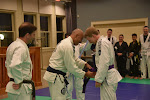I haven't found much information about training to run long distances if you have ITBS (Iliotibial Band Friction Syndrome), so I've decided to post this little experiment that I'm conducting. my goal is to see how well I can condition my ITB in eight weeks. in other words, how far will I be able to run without my ITB flaring up so badly that I decide to stop. last summer I made it to 18KM.
this isn't a doctor recommended schedule by any means, so do not try and use my numbers without consulting a doctor first. ideally, this sort of conditioning would be stretched out (pardon the pun) over a much longer period of time. for example, here's a good kilometer build-up schedule. you'll see on my schedule below that I break many of the rules (e.g. don't add more that 10% per week).
what is ITB?
"ITBFS is an overuse injury specifically referring to an irritation and subsequent inflammatory reaction of the lower iliotibial band. This occurs due to repetitive frictioning of the band as it rubs over the bony prominence of the lateral epicondyle of the femur during flexion (bending) and extension (straightening) of the knee." - from Serpentine Running Club
so basically your hurts more and more until it finally just ceases to work. it's a frustrating problem because you can feel great in every other way, but your knee flares up like a guy fawkes celebration.
stretches for ITB:
NISMAT - http://www.nismat.org/ptcor/itb_stretch
here are my rules for conditioning my ITB:
Rule 1: increase your distance by actually running longer distances - the only way to be sure that you can cover a certain distance is to do it.
Rule 2: stretch, stretch, stretch - many times per day
Rule 3: don't train on a treadmill - running on a treadmill is fine for cardio, but it isn't going to do much for your ITB. treadmills are obviously flat and it's the little undulations in running surfaces that cause the most irrtation for the ITB.
Rule 4: rest and ice when your ITB is inflamed - I read one person's opinion that running with a sore ITB is counterproductive. rather than increase your distance, you'll just hamper your ability to run the next day. this is intuitive, but hard to remember when you just want to run those last few KMs. after every run, I soak in a hot bath for 15 min (for my muscles) and then ice my knee (for any ITB irratation).
I'm basing my schedule on how my knee feels. if it starts to get irratated, I'll ease off. if it feels good, I'll add distance.
training schedule (in addition to other activities, such as 3-5 martial arts classes per week):
Day 1: 5K run 3K walk (ITB sore as hell)
Day 2: 2K run (ITB too sore to run)
Day 3: 8.5 K run (ITB fine)
Day 4: 11K run, rest, 4K walk (ITB fine)
Day 5: 11K run (ITB fine, but my legs need a rest day)
Day 6: Rest and stretching (professional massage therapy appointment)
Day 7: Rest and stretching (due to heavy rain)
Day 8: Rest and stretching (due to heavy rain again... arggh)
Day 9: 21K run (ITB fine) - I planned 15K, but I felt great (legs need a break though)
Day 10: 5K walk, rest and stretching
Day 11: 4K run (ITB fine)
Day 12: Rest and stretching (due to other sports)
Day 13: 22K run (ITB fine)
now that my experiment has been successful, I'm switching to a more traditional marathon training schedule. if training goes well for the next few weeks, I'll enter the Nova Scotia Marathon.
Thursday, June 01, 2006
Subscribe to:
Post Comments (Atom)



2 comments:
This is terrible advice. First of all ITBS and "runner's knees" are two distinct injuries. Soaking in a hot tub will increase the inflamation - much better is to soak in a cold iced-bath.
Do some research around on ITBS.
anonymous, do you always comment with that tone?
you completely missed the point. my post was based on actual experience--so I know that this works for me. I don't think you'll convince me to change a plan that helped me achieve my goal.
cold is obviously good for acute injuries, but the whole point of this post was to avoid acute injury. in this case, heat helps the recovery process.
all you have to do is google and you'll find supporting research: "ILIOTIBIAL BAND SYNDROME INJURED RUNNERS INCREASE FLEXIBILITY USING
SOFT TISSUE MOBILIZATION AND INCREASE FUNCTIONAL STRENGTH USING A
HEAT PACK-IMPLICATIONS FOR FASTER RECOVERY"
your first comment about runner's knee was valid, so I've made that change. thanks.
Post a Comment